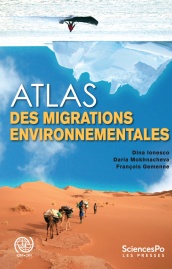Environmental Migrations Represent more Displacements than Violence and Conflicts

INTERVIEW
Sustainability MAG: As migration and climate change related topics are covered everyday, how can we understand the link between these two phenomenons?
Daria Mokhnacheva: Today, the links between environmental challenges and migration dynamics are better understood thanks to increasing research on the topic, driven by the growing political interest for these issues, at the local and global level. We know that sudden disasters (storms, floods or non-climatic phenomena such as earthquakes) are major causes of forced displacement for these populations. They cause around 26.4 millions of new displacements each year according to the Internal Displacement Monitoring Centre (IDMC), which represent more displacements than those caused by violence and conflicts.
Furthermore, we evaluate an even higher number of people moving because of slow environment degradations (desertification, deforestation, rise in sea level). Effects of climate change and demographic trend will worsen these risks, leading in some cases to forced displacements, or in other cases, on the contrary, to a rising insecurity for populations unable to leave the risk areas, falling into a trap in these high-vulnerability situations. Migration has to be understood in the climate change context not only as a risk factor but also as a potential positive solution which could allow some vulnerable populations to access safer living conditions and to diversify their means of subsistence. Many studies show the positive effect of migration on the adaptation to climate change and sustainable development, especially through migrants’ contribution to the development of their original country. It is this positive vision of migration, as an individual or collective adaptation as well as a disaster risk reduction strategy that the IOM promotes through its on-site activities as well as its spolicy support and interstate dialogue.
Migration is a multi-causal phenomenon. Could you elaborate more on this?
Migration is a very contextual phenomenon. It is often the result of the interaction of many forces (economical, political, social, demographic and environmental) acting at different levels (societal, community, individual). It is rare that an environmental factor on its own is the only cause leading to migration, except for sudden disasters causing immediate forced displacements. In most cases, environmental stress is added to, or influences, other factors leading to migration, such as jobs and income availability, food safety, or even conflicts linked to resources. Finally, we often forget about the role of choice, capacities and individual considerations in the decision to migrate, that are indeed central to all migrations. This is precisely the multi-causality that the “Atlas des migrations environnementales” aims at demonstrating that climate migrations management needs a cross-disciplinary approach, in order to adapt to the context, the nature of the movement, and to the needs of the affected populations.
Displacements are more numerous within countries than outside. How do countries deal with that?
We estimate that most forced displacements following disasters are done within countries, even if some displacement cases beyond borders have been identified. More and more research and political dialogue, especially in the context of the Nansen initiative and the Platform have linked displacements to disasters. In case of disasters, each country has its own measures regrading crises and local emergency situation management. States can also ask for the support from global humanitarian actors. Since 1992, the Inter-Agency Standing Committee of the UN, which coordinates humanitarian intervention and the International Federation of the Red Cross have helped affected or displaced people. This type of humanitarian intervention is also a main part of what IOM is doing on-site, along with the HCR (UN Agency for refugees), which is responsible for the management of camps within this inter-agencies coordination group.
More countries are including measures in their national legislation regarding the protection of internal displaced during disasters. Some also put measures in place offering the protection to foreign nationals. The introduction of these measures in national policies and their implementation are still unequal and often not enough. Moreover, existing measures rarely take into account the globality and the complexity of the migratory phenomenon and its implications (social, environmental, urban and development). It is thus essential to continue the advocacy and dialogue efforts at the international, regional and national levels to promote the development of more comprehensive policies and regulatory frameworks that are adapted to the needs of the displaced people in case of disasters.

Daria Mokhnacheva
is Program Officer in the division “Migration, Environment and Climate Change” at the International Organisation for Migrations (IOM). At the Platform on Disaster Displacement, she is responsible for the implementation of activities related to the work program. As a specialist on issues related to disasters impact and environment change on societies and the development, she co-wrote the Atlas on environmental migrations.
To be read also in the dossier "The climate-displaced":

